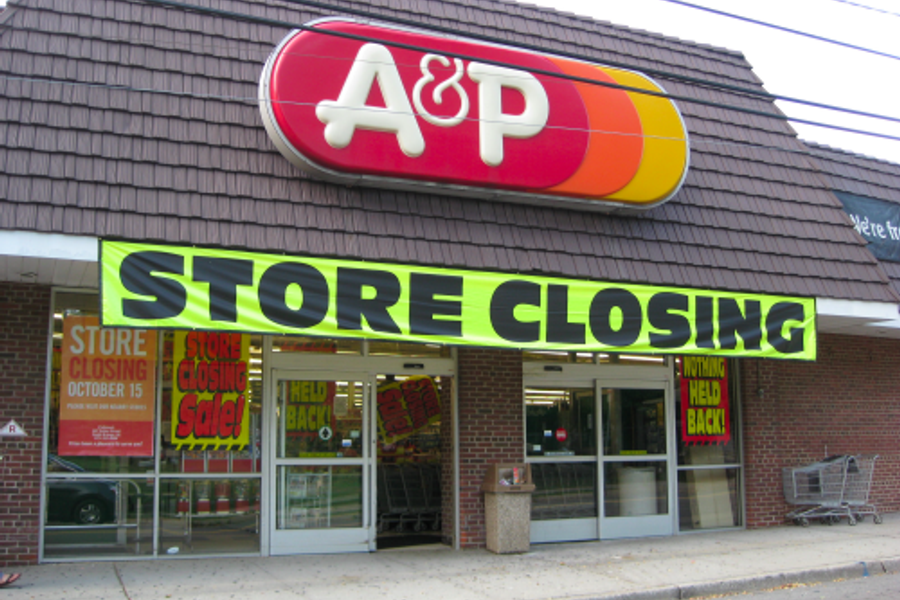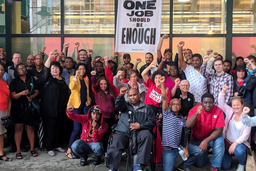Grocery Chain A&P’s Financial Meltdown Could Leave Thousands of Union Workers Jobless
Bruce Vail

Plans to dismember the A&P supermarket chain were revealed in a federal bankruptcy court in New York this week, with dire results predicted for more than 15,000 members of the United Food and Commercial Workers (UFCW) union.
The historic grocery retailer — the original Great Atlantic & Pacific Tea Co. was formed back in 1859 — intends to sell or close all of its 300 stores spread across six Mid-Atlantic states, according to documents filed Monday in the U.S. Bankruptcy Court for the Southern District of New York. The plan will affect every one of an estimated 30,000 UFCW members currently employed with the company, with more than half of those in real danger of losing their jobs soon, union officials say.
The bad news for the union was partially tempered with the announcement that A&P had already lined up the sale of 120 of its stores to other regional grocery chains that also have UFCW contracts. If those sales go forward as planned, most of the 12,500 union members at those 120 stores would be expected to retain their jobs under the new owners. The prospective buyers — ACME Markets, Ahold USA (operator of Stop & Shop) and Key Food — already have UFCW collective bargaining agreements covering the 120 stores in Pennsylvania, New York and New Jersey (A&P stores are also located in Connecticut, Delaware and Maryland).
But those plans don’t include any future employment for workers at the other 180 stores, including 25 that A&P says it will seek to close immediately. All sales or closures are subject to approval by Bankruptcy Court Judge Robert Drain, and the process of selling off or closing stores is expected to begin soon but drag out for months. ACME Markets, for example, issued a statement saying that it didn’t expect to finalize purchase of any A&P stores until mid-October.
Very few union members were taken by surprise by these developments, says Wendell Young IV, President of UFCW Local 1776 in Philadelphia. A&P, which also operates under the trade names of Pathmark, Waldbaums and Superfresh, has been ailing financially for years, he says, and underwent a painful bankruptcy reorganization in 2010-2012.
“I’ve been telling my members for two years that I didn’t think A&P was going to make it. We’ve been doing everything we can as a union to be prepared for this,” he tells In These Times.
The final demise of A&P was signaled last September, Young continues, when company executives announced a debt refinancing package that failed to include any new investment in the company. Rumors swept the supermarket industry soon afterwards that executives were intent on dismembering the company by selling off its valuable pieces, and discarding the rest, he says.
Young adds that part of the union preparation has been to revive a coalition of 12 separate UFCW locals with A&P contracts. Supported by legal experts and financial resources from the UFCW International headquarters in Washington, D.C., the coalition was first formed in 2010 to present a united labor front in dealing with bankruptcy issues at that time. The coalition ceased active operation when A&P emerged from the first bankruptcy proceeding in 2012, but was revived in June as a crisis at A&P appeared imminent, Young says. UFCW Local 1500 in New York, with about 5,000 members employed with A&P, is one of the coalition members most affected by the bankruptcy.
UFCW Region 1 Director Tom Clarke, who heads the coalition, did not respond to In These Times calls seeking additional information and comment.
Christopher McGarry, A&P’s Chief Administrative Officer, began the bankruptcy process by threatening the unions. In a declaration dated July 19 and filed with the court July 20. McGarry warned:
It is imperative that the parties cooperate with one another and that negotiations be conducted as expeditiously as possible. While the Debtors are committed to pursuing consensual resolutions with their unions where possible, if consensual resolutions cannot be quickly achieved within the required deadlines imposed…the Debtors will be required to commence proceedings under sections 1113 and 1114 of the Bankruptcy Code to seek authority to implement both temporary and permanent modifications to the CBAs on a unilateral basis.
Section 1113 is the section of the bankruptcy code commonly used to cancel or revise labor contracts, even without any agreement from unions or union members.
The coalition will resist any attempts by A&P to use bankruptcy law to cancel existing UFCW collective bargaining agreements. “If the process is to be the orderly sale or closure of all the stores, then there is no need to cancel any contracts. The union is fully prepared to negotiate decent contracts with any of the new owners, and in the case of store closings, the existing contracts should be honored by all the parties,” Young says.







